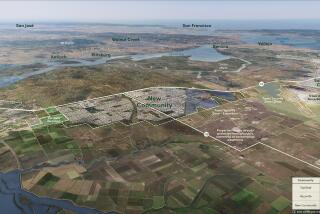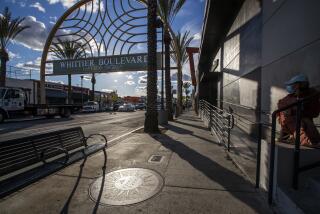Secession Backers Off to Slow Start
Leaders of the move to break up Los Angeles have been slow to get political campaigns started, falling behind their opponents in organization, fund-raising and endorsements.
The grass-roots efforts to form new cities in the San Fernando Valley and Hollywood are struggling to build a campaign structure. The Valley group has just sent out its first fund-raising letter and has yet to schedule a rally.
Instead, secession proponents have been conducting what might be called a living-room war, attending coffee klatches, community meetings and local festivals to make their case. In this way, they hope to play tortoise to Mayor James K. Hahn’s hare, crawling steadily toward a November victory while opponents, led by the mayor, grow cocky and careless.
But leaders of the secession campaigns concede they will have to use more conventional--and expensive--means to reach enough voters in a city the size of Los Angeles, including television and radio advertising. On this front, they say, work has just begun.
Meanwhile, Hahn, with sophisticated political machinery at his disposal, has been on the stump nearly every day.
He pulled in more than $200,000 at a fund-raising dinner last week. He drew 700 union members and other supporters to a rally in Sherman Oaks last weekend and addressed a downtown crowd of 1,000 Monday night.
At one event after another, Hahn has been telling voters that the secession measures on the Nov. 5 ballot would mean financial ruin for Los Angeles and the proposed cities, a claim that supporters say is groundless. He also has picked up a broad range of anti-secession endorsements--from the man he beat in last year’s mayoral campaign, Antonio Villaraigosa, to the state and local Democratic Party, to a coalition of African American leaders, among others.
“The mayor obviously has a decided edge,” said Hollywood secession leader Gene LaPietra. “He’s using city employees and city resources to wage a 24/7 campaign with taxpayer dollars.”
On the other side, in the weeks since the Local Agency Formation Commission voted to put secession proposals on the ballot, supporters have been trying to woo contributors and convert their group of mostly political amateurs into a force capable of taking on some of the most sophisticated campaign strategists in California.
Now, with some money finally in hand (they won’t say how much), Valley secession supporters have hired a professional organizer and a fund-raising consultant. They also plan to begin distributing pamphlets in the next couple of weeks.
“We have spent the time sharpening the edges of our organization,” said Richard Katz, the former state assemblyman who chairs the Valley pro-secession campaign.
Katz and others say summer is a slow time in politics, when campaigns shore up their base and plan for the fall. And even without an aggressive outreach plan, the message of smaller and more responsive city government has spread via news media and neighbor-to-neighbor, secession advocates say.
But the mayor, who has a built-in political base and campaign workers in place from his last election, has a huge advantage, said Sacramento political consultant David Townsend.
“He’s got his organization, and he’s moving,” Townsend said. “That’s a tremendous head start over the rebel forces there that are trying to get organized.”
Add to that the mayor’s apparent fund-raising lead--Hahn said he intends to wage a $5-million campaign--and the fight for secession will be an uphill one indeed, Townsend said.
Hahn’s camp feels so certain of victory, one insider said, that he has decided he doesn’t need to take a stand on a proposed ballot measure that would organize Los Angeles into boroughs--even though many believe that such a plan could win votes from secession advocates.
The mayor is addressing ever-larger groups, and his rallies have the flavor of old-fashioned politics.
At the labor rally last weekend, dozens of people queued up behind a bullhorn, waiting for the chance to shout their names and pledge to work against secession.
But in the coffee-klatch war, hardly a meeting ends without residents coming up to Katz and offering to help.
At a meeting of the Pacific Palisades Democratic Club last Sunday, a group so liberal that some of its members are trying to revive the nuclear freeze movement of the early 1980s, Joan Reitzel told Katz he had her vote.
“I’m going to vote for it,” said Reitzel, who lives in Venice and is angry that her Los Angeles council district was eliminated and merged with that of the Palisades.
If the Valley secedes and the city is smaller, Reitzel reasoned, her community will get its own district once again.
“Come and join us,” Laurette Healey, an openly gay Sherman Oaks resident who is running for a city council seat on the Valley secession ballot, told members of the Stonewall Democratic Club in North Hollywood.
Ben Goddard, political strategist for the secession campaigns, said that Katz and others have spoken at 30 community meetings in the last month or so, with 50 more scheduled for July and August. They will address audiences ranging in size from a dozen people in a living room to 100 or 200 in a community hall, Goddard said.
Particularly in the Valley, he said, this is the way the campaign will be waged at least through the summer: in a careful slog from group to group, house to house, known in the world of electoral politics as a “retail” campaign, where individual voters, rather than a mass audience, are the targets.
“It’s a community-based movement with broad-based grass-roots support, so that’s where most of our visible activities are going to be,” Goddard said. “That’s going to be the tone of our campaign until we get into the fall, when we’ll start using more mass media and paid media.”
Goddard said he does not believe the secession movement lost ground in the last month.
“In the best of all possible worlds, the LAFCO process would have been completed in early spring so we could have moved into campaign mode a little quicker,” Goddard said. “But given the calendar, I’m very pleased with where we are now.”
In the last week, Valley secession advocates have begun to train volunteers to walk precincts and participate in debates. They also announced endorsements from half a dozen Valley chambers of commerce. The letter sent to 25,000 prospective donors marked the start of a fund-raising drive whose goal is $4 million.
In Hollywood, secession proponents will continue to focus on the neighbor-to-neighbor strategy over the summer.
“Hollywood is a small community. We can actually get enough volunteers to go door-to-door,” LaPietra said.
Roy Behr, a Democratic political consultant based in West Los Angeles, said it was appropriate for the pro-secession campaigns to take time to reorganize before embarking on a major outreach effort.
Between now and Labor Day, Behr said, it will be important for both sides to do the kind of painstaking, person-to-person outreach that will bring in a flood of volunteers and money for the fall campaign.
“Now we’re in the prolonged period of time when both campaigns need to do infrastructure and strategizing and research,” Behr said. “The vast majority of communication with voters doesn’t take place until the last moment.”
More to Read
Sign up for Essential California
The most important California stories and recommendations in your inbox every morning.
You may occasionally receive promotional content from the Los Angeles Times.










![[20060326 (LA/A20) -- STATING THE CASE: Marchers organized by unions, religious organizations and immigrants rights groups carry signs and chant in downtown L.A. "People are really upset that all the work they do, everything that they give to this nation, is ignored," said Angelica Salas of the Coalition of Humane Immigrant Rights. -- PHOTOGRAPHER: Photographs by Gina Ferazzi The Los Angeles Times] *** [Ferazzi, Gina -- - 109170.ME.0325.rights.12.GMF- Gina Ferazzi/Los Angeles Times - Thousands of protesters march to city hall in downtown Los Angeles Saturday, March 25, 2006. They are protesting against House-passed HR 4437, an anti-immigration bill that opponents say will criminalize millions of immigrant families and anyone who comes into contact with them.]](https://ca-times.brightspotcdn.com/dims4/default/34f403d/2147483647/strip/true/crop/1983x1322+109+0/resize/840x560!/quality/75/?url=https%3A%2F%2Fcalifornia-times-brightspot.s3.amazonaws.com%2Fzbk%2Fdamlat_images%2FLA%2FLA_PHOTO_ARCHIVE%2FSDOCS%2854%29%2Fkx3lslnc.JPG)